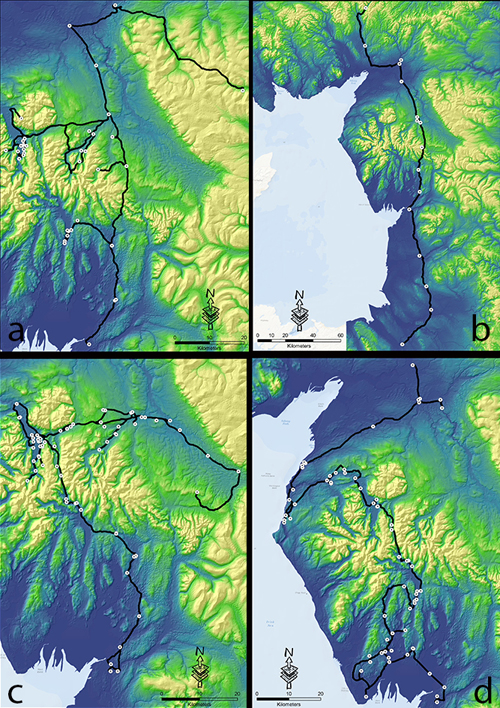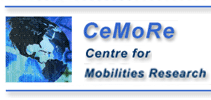

Position Statements & Abstracts
Peter Merriman - Mobility Cultures and the embodied practices of early British motoring
In this paper I discuss the role of arts and humanities approaches in recent research on mobility before outlining some of my own research on driving practices. I examine how distinctive embodied dispositions and sensibilities of driving emerged and were conceptualised and experienced by motorists and social commentators in late nineteenth and early twentieth century Britain, as pioneering motorists undertook the complex process of becoming auto-mobile. I examine how these embodied practices and sensations were codified and understood by motoring pioneers, aesthetic commentators, and medical experts; exploring how they were incorporated into the embodied spatialities of motoring and non-motoring publics. I show how in these early days of open-topped motoring, hearing was deemed just as important as the visualities of motoring, while questions of touch, exposure, warmth, and comfort emerged at the heart of many discussions about the sensations and sensibilities of practices of motoring. In the paper I pay particular attention to the technologies which were seen to cultivate distinctive sensations, sensibilities and cultural practices of motoring, ranging from glass screens and goggles, to headlights and specialist clothing.
Ian Davidson - Mobility, Subjectivity and Modern Poetry
After an early life characterised by mobility, the poet Bill Griffiths settled in Seaham in County Durham where he immersed himself in the local culture, becoming an expert in northern dialect and in local history. An Anglo Saxon scholar, Griffiths was a one time motorcyclist and member of a motorcycle gang, lived in temporary squat accommodation in London, was a guest worker in Germany and lived on a houseboat in the UK, constructing patterns of living that challenged notions of ‘home’. He also had a lifelong interest in the enforced immobility of prison life and the notion of justice. He not only experienced prison himself, but also often championed the causes of prisoner rights. This essay examines the way that the political and material implications of ideas of movement, practices of mobility and automobility, and enforced immobility through imprisonment, are evident in his poetic work, and claims that movement is a process that reveals things about the mobile subject, and those spaces the subject moves through.
Christopher Donaldson and Patricia Murrieta-Flores - Site lines: mapping eighteenth-century tourism in the English Lakes
 A number of pioneering studies have recently identified the transformation potential Geographic Information Systems (GIS) and related geospatial technologies for humanities research.* These studies have manifestly enriched our understanding both of the evolution of specific geographies and of the potential of GIS, and its cognates, for literary and cultural-historical research. At the same time, however, these studies share a common limitation in that they rely on the analysis of point-based cartographic representations. Point-based maps are suitable for representing quantitative geographical phenomena, but they are less adequate for representing qualitative human phenomena. This is a major impediment, especially for researchers who aspire to analyse the geographical experiences and spatial relationships embedded in literary texts. This presentation suggests a way of overcoming this impediment by demonstrating how innovative geospatial techniques, such as Cost-Surface Analysis and Least-Cost-Path Analysis, can facilitate more nuanced interpretations of the journeys of historical travellers. It does so by constructing comprehensive and coherent visual models of the tours of three canonical Lake District tourists: Thomas Pennant, Thomas Gray, and Arthur Young.
A number of pioneering studies have recently identified the transformation potential Geographic Information Systems (GIS) and related geospatial technologies for humanities research.* These studies have manifestly enriched our understanding both of the evolution of specific geographies and of the potential of GIS, and its cognates, for literary and cultural-historical research. At the same time, however, these studies share a common limitation in that they rely on the analysis of point-based cartographic representations. Point-based maps are suitable for representing quantitative geographical phenomena, but they are less adequate for representing qualitative human phenomena. This is a major impediment, especially for researchers who aspire to analyse the geographical experiences and spatial relationships embedded in literary texts. This presentation suggests a way of overcoming this impediment by demonstrating how innovative geospatial techniques, such as Cost-Surface Analysis and Least-Cost-Path Analysis, can facilitate more nuanced interpretations of the journeys of historical travellers. It does so by constructing comprehensive and coherent visual models of the tours of three canonical Lake District tourists: Thomas Pennant, Thomas Gray, and Arthur Young.
*Notable examples include the ETH Zurich’s Literary Atlas of Europe, the Stanford Literary Lab, Trinity College Dublin’s Literary Atlas of Ireland, Lancaster University’s Spatial Humanities: Texts, GIS, Place, the University of Edinburgh’s Palimpsest Project, and the University of Queensland’s Cultural Atlas of Australia.
Ruth Livesey, ‘Locality and Nation on the Move: The Case of Walter Scott’
How does fiction work to give a sense of place? And how can the novel – a commodity that circulates and is consumed by distant readers – nevertheless whip up passionate attachment to a particular locality? Walter Scott’s Waverley series of historical novels was phenomenally popular and truly international in reach during the nineteenth century, inventing and reproducing Scotland (or Scott-land) for a global readership. Yet one of the surprises of returning to these now scarce-read works is how little they contain in the way of landscape or detailed descriptions of locale. Scott’s novels, I argue, were so significant in their own times because they rehearsed an interactive mode of consuming locality in an era of mass mobility. This was not the measured gaze of the tourist glancing at leisure from the window of a coach at a fixed landscape with figures, but plots of collision and upset, diverting readers and protagonists alike off national coach roads on foot into populated territory. Place comes into being in the contest between his modern protagonists and indigenous characters on these byways; the latter speak from a particular locality whilst remaining, nevertheless, on the move outwith the routes of the nation.
Charlotte Mathieson - Victorian literary mobilities: the case of Dickens's Bleak House."
This paper explores the productive intersections to be made between mobility theory and literary studies, focusing on Charles Dickens’s Bleak House (1852-3) as an exemplary model of the prevalence of mobility in the Victorian novel. I start by considering how moving from a concept of ‘travel’ to a framework of mobility studies reveals a rich and varied range of journeys in Bleak House, reflecting the vastly expanding travel culture of the nineteenth century and demonstrating its impact upon the structural devices and representation modes of literary narratives. I then consider how reading these journeys provides new perspectives on the novel’s handling of national and global space, suggesting that Dickens uses mobility as a positive and productive force which serves to connect and demarcate the nation-place, whilst recognizing the inextricability of Britain’s connection to the world beyond as an inevitable consequence of the move into mobile modernity.
Lesley Murray - Gendered and generational representations of mobilities in urban fiction
This paper draws from my co-edited (with Sara Upstone) book Researching and representing mobilities (Palgrave, September 2014) as well as a recently accepted journal article (Transfers, coming soon). In particular, I focus on two studies: one of gendered mobilities through a number of works of fiction that are based in London; and the other of children’s mobilities through the children’s book Emil and the detectives, along with two if its film adaptations. I question the role of fictional stories, and the different ways they are represented, in revealing aspects of urban mobilities that are often obscured. This is achieved through critical ‘mobilities’ readings of these accounts. The paper begins by considering the representations of the ‘dangerousness’ of women’s mobility in contemporary London fiction (Murray and Vincent 2014). I then use Emil and the detectives to take a critical look at the concept of ‘children’s independent mobility’, which underpins much of the research on children’s mobilities. A number of key and interlinked ideas emerge from both studies, which centre on the fluidity of the texts in space and time, the significance of the reader or viewer, and most importantly the underexplored role of imaginative mobilities.
Colin Pooley - Using life-writing to interpret everyday mobility in the past.
In most societies the ability to move easily from place to place is a taken-for-granted aspect of twenty-first century life, but much less is known about such mobility in the past. There is also a tendency for accounts that do exist to focus on the exceptional rather than the routine. In this paper I use two personal diaries written in England in the mid-nineteenth and early-twentieth centuries to explore the ways in which everyday mobility was accomplished in the past. One diary was written by a middle-aged man living in London in the 1850s and ‘60s, and the second belonged to a young woman living in Manchester in the first decade of the twentieth century. Neither diarist had a public persona. Attention is focused on the ease with which people could move around, the variety of modes of transport used, the enjoyment that travel generated, and the difficulties that were encountered. It is concluded that, for these two diarists at least, frequent everyday mobility was commonplace and mostly unproblematic, and was as closely enmeshed with society and economy as is the case in the twenty-first century. In conclusion the potential generalizability of such evidence is discussed.
Fiona Wilkie - Mobilising Titanic: performing civic identities at the Made in Belfast festival
This paper draws on material from my book project Performance, Transport and Mobility, which will be out with Palgrave in November. In it, I discuss ideas of mobility and immobility in relation to the Titanic – Made in Belfast festival, held in April 2012 to mark the centenary of Titanic’s sinking. The festival, combining plays, concerts, readings, installations, exhibitions, lectures and memorial services, seems a curious event: it sought to invent a positive civic image out of a vessel that has become a byword for disaster. I am particularly interested in the multiple and sometimes conflicting ways in which the festival made use of the ship as symbol and as a strategy for rebranding a capital city with a violent history. The paper explores claims made for the types of mobility that were ‘made in Belfast’ in 1912 and that were constructed through arts events a hundred years later. More broadly, I will position the discussion of the festival within the context of my wider investigation into how performance might ‘make passage’, shaping our experiences and understanding of being on the move.
